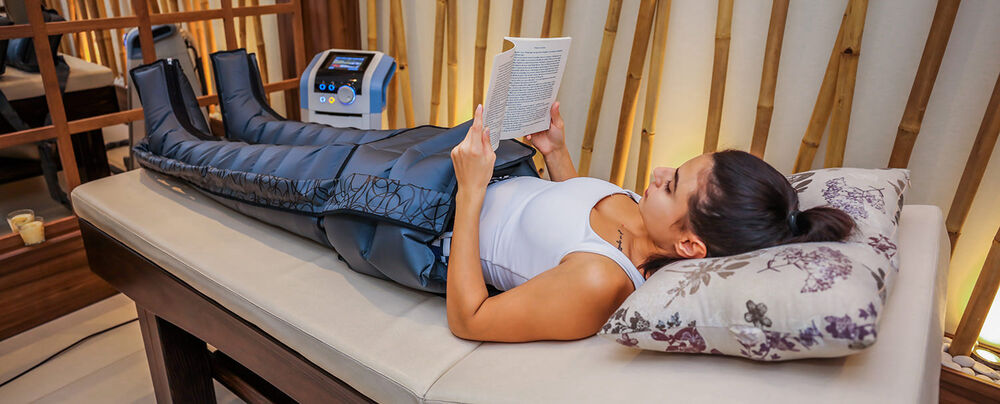Answers to the questions – Why do legs swell up? and How to deal with swollen arms and legs?
The lymphatic system is an important part of the immune system. It consists of a network of lymph vessels that carry lymph fluid. Lymph is a fluid that contains lymphocytes, protein, along with mobile particles with bacteria.

Lymphedema is a swelling of the extremities due to trauma or blockage of the lymphatic system, and the consequential collection of protein-rich tissue fluids in the intercellular space. High protein content causes tissue fibrosis, which obliterates new lymph vessels and worsens the symptoms of lymphedema.
Lymphedema is caused by a removal or trauma of lymph nodes during cancer treatment. Unfortunately, lymphedema is incurable, but it can be controlled. This involves diligent care of the swollen extremity.
According to the clinical results and stage of the disease, lymphedema (swollen legs and arms) can be divided into :
- Mild (swelling which caves under pressure, recedes after the limb is raised, without skin and subcutaneous tissue fibrosis)
- Moderate (the swelling does not cave under pressure and does not decrease upon elevation, and signs of fibrosis are present), and
- Severe (swelling is irreversible; the skin is thick and fibrotic with areas of hyperkeratosis. The skin looks like an orange peel, and in the final stages, the swelling is so pronounced that the legs look like elephant’s legs – elephantiasis.).
Lymphedema comes about when your lymph vessels cannot drain the lymph fluid properly, usually from the arms or legs. Lymphedema can be primary or secondary. Primary means that it can appear on its own, while secondary signifies that it is a consequence of some other disease or condition.
Causes of secondary lymphedema (swollen arms and legs)
The causes can be conditions or actions that damage lymph nodes or lymph vessels:
- Surgery – Lymphedema can occur if you have removed or shrunk the number of your lymph nodes. For example, breast surgery can involve the removal of one or more lymph nodes from the armpit while searching for evidence of cancer expansion. If the remaining lymph nodes and lymph vessels cannot compensate for the missing ones, lymphedema can develop in the arm.
- Radiation therapy – radiation may cause scarring and inflammation of the lymph nodes or vessels, thus limiting the flow lymphatic fluid.
- Carcinoma – if malignant cells are blocking lymph vessels, lymphedema may develop. For example, if a tumour were to grow next to a lymph node, it might become as large as to block the flow of lymphatic fluid.
Causes of primary lymphedema (swollen legs / swollen joints of the arms and legs)
Primary lymphedema is a rare hereditary condition caused by problems in the development of the body’s lymph vessels. It is more common in women.
Specific causes of primary lymphedema include:
- Milroy’s disease (hereditary lymphedema) – a hereditary disease that begins in early childhood and causes an abnormal development of lymph nodes, which leads to lymphedema.
- Meige disease – this hereditary disease can often cause lymphedema during childhood or puberty, but it can also occur during the twenties or early thirties.
Symptoms of lymphedema (arm and leg swelling):
- Swelling of a part of the arm or leg, swelling of the entire arm or swelling of the leg, including toes
- A feeling of weight or pressure in the arm or leg
- Limited mobility in the arm or leg
- Pain and unease in the arm or leg
- Recurring infections to the affected extremity
- Thick skin in the arm or leg
Lymphedema diagnostic procedure (swollen extremities)
Evaluation (assessment) of the condition
An individual examination performed by a doctor and chartered physiotherapist aimed at determining the cause of the lymphedema. By applying specialised diagnostic procedures along with anthropometric measurements (range of motion, extremities size), we can determine the cause of pain. The goal of the assessment is to reach a medical and physiotherapy diagnosis.
Physiotherapy diagnosis is a thorough report made by a specialist of physiotherapy with a detailed description determined through a previous evaluation. An individual treatment and rehabilitation plan is created after formulating a diagnosis, depending on the type and degree of injury. The application of machine techniques alongside manual techniques ensures a full scope of rehabilitation aimed at maximising the effect of lymphedema treatment.
Treatment plan and rehabilitation programme
Any injury or painful condition is treated individually. Treatment plans can depend on the time and cause of the lymphedema.
Treating lymphedema (arm and leg swelling):
- Pressotherapy – applying an adequate programme of lymphatic drainage stimulates the detoxification of the organism through moderate pressure to the upper or lower extremities
- Manual lymphatic drainage – activates the lymphatic system and reduces the symptoms of lymphedema.
- Kinetic therapy – a mandatory programme of individual, targeted exercises.
- Neuromuscular kinetic taping – aims at improving drainage twenty-four hours a day and significantly accelerates lymphedema symptoms alleviation.


